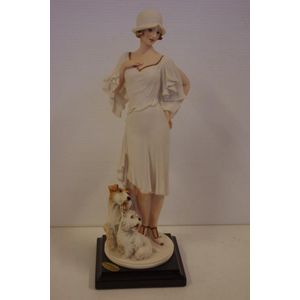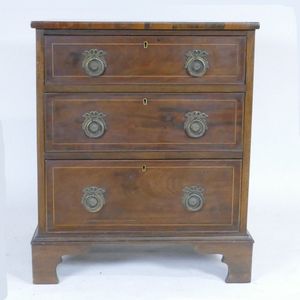Edwardian Sheraton Revival Mahogany Chest with Shell Inlay
You must be a subscriber, and be logged in to view price and dealer details.
Subscribe Now to view actual auction price for this item
When you subscribe, you have the option of setting the currency in which to display prices to $Au, $US, $NZ or Stg.
- Parquetry - Parquetry is inlay laid in geometric patterns, the contrast being achieved by the opposing angles of the grain and veneers. The herringbone pattern is the most commonly used in flooring, but this is almost never seen in furniture - the patterns used are more complex and unlike flooring, can include several different varieties of timber.
- Edwardian - The Edwardian period of English furniture and decorative arts design is named for Edward VII (1841 ? 1910) who was King of the United Kingdom and the British Dominions and Emperor of India for the brief period from 1901 until his death in 1910. It follows the Victorian period, in turn was followed by the Art Nouveau and Art Deco styles. In Australia, designs of this period are also known as being in the Federation style.
- Bracket Feet - On bracket feet the corner edge is square and joined by a mitre to its partner on the opposite angle. The inner edge is usually shaped or scalloped. Bracket feet were first introduced in the early 18th century and used until c. 1830 and are found on carcase furniture such as chests, cabinets, bookcases and bureaux.
Ogee bracket feet, a variation on straight bracket feet, have the outside edge forming an "S" shaped curve with the top bulging outward and the bottom turning inward.
On splayed bracket feet, the exterior edge curves outward. - Thomas Sheraton - Thomas Sheraton (1751-1806) was born in Stockton on Tees in the north of England. He was apprenticed to a local cabinetmaker and after working as a cabinetmaker, Sheraton moved to London about 1790. Although he described himself as a cabinet-maker, like Chippendale, no definite piece of furniture can be traced to him as maker. Nevertheless, he was immensely influential and in 1791-4 published his four volume book 'The Cabinet-Maker and Upholsterer's Drawing Book'. The books were used as source of design by the furniture-making trade , who often simplified or modified the designs to suit their own preferences. Sheraton furniture is marked by restraint and sophistication, elegance and discretion, though he also found time to invent fanciful combination furniture.
- Inlay - Decorative patterns inserted into the main body of a piece of furniture, generally in wood of contrasting colour and grain, though brass, ivory, ebony, shell and sometimes horn have been used. Inlay may consist of a panel of well figured timber inset into a cabinet door front, geometric patterns, or complex and stylized designs of flowers, swags of foliage, fruits and other motifs. As a general rule, in pieces where the carcase is constructed in the solid, the inlay is relatively simple such as stringing, cross banding and herringbone banding. Where more elaborate and decorative work was required veneer was used. Inlay has been fashionable from at least the latter half of the 17th century, when a variety of elaborate forms were developed
- Mahogany - Mahogany is a dense, close grained red-coloured timber from the West Indies and Central America. It was first imported into Europe in the the early 18th century and its use continued through the 19th century. It was popular for furniture making because of its strength, the wide boards available, the distinctive grain on some boards, termed flame mahogany and the rich warm colour of the timber when it was polished.. The "flame" was produced where a limb grew out from the trunk of the tree, and this timber was usually sliced into veneers for feature panels on doors, backs and cornices.
Some terms used to describe mahogany relate to the country from which it originally came, such as "Cuban" mahogany, "Honduras" mahogany etc. However unless the wood has been tested the names assigned are more a selling feature, rather than a true indication of the timber's origin.
This item has been included into following indexes:
Visually similar items

A Sevres first Empire coffee can and saucer, circa 1804-9 period. The straight-sided can with an ear form handle with continuous floral and sprigged borders in gilt and cobalt blue, the saucer conforming, with an iron red mark of the period underside to ca

19th century marble tazza with seven Pietra-Dura oval medallions

Tony White silver and mother of pearl necklace stamped 'STG. SIL' and 'White' length 28 cm

Naples 'Florence' lady figurine, by Giuseppe Armani, 31 cm high approx.
